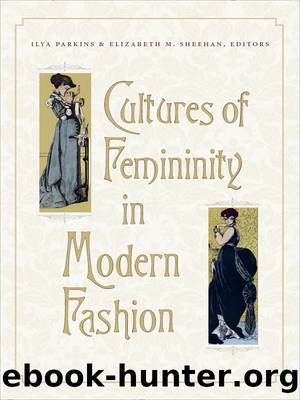Cultures of Femininity in Modern Fashion by Parkins Ilya;Sheehan Elizabeth M.;Felski Rita; & Elizabeth M. Sheehan

Author:Parkins, Ilya;Sheehan, Elizabeth M.;Felski, Rita; & Elizabeth M. Sheehan
Language: eng
Format: epub
Publisher: University of New Hampshire Press
While Mrs. Linton draws attention to the inadequacy of the visual as a method of determining meaning, her article expresses further anxieties about visuality and feminine visibility. Perhaps more problematic than the apparent likeness between ârespectableâ women and prostitutes is the possibility that, through the reciprocal transaction of viewing, the female gaze itself could be corrupted. For according to Mrs. Linton, the perfect imitation of the dress of the demimondaine depends upon an exchange of glances between the lady and the prostitute. She writes, âOur modest matrons meet,â not âto stare the strumpet down,â but âto compare notes, to get hints, and to engage in a kind of friendly rivalryâin short, to pay that homage to Vice, and in a very direct way too, which Vice is said formerly to have paid to Virtue.â48 In this way, the female observer misuses her power, using her eyes not to morally defeat the courtesan, but instead to engage her in solidarity by means of a shared, expressive stare. As a result of this, Mrs. Linton identifies a growing, uncomfortable similarity between âViceâ and âVirtue,â as the process of sartorial imitation might encourage, excuse, or normalize âfastâ or sexually daring conduct. What emerges is a sense of fear that, as Valerie Steele has argued, ânot only might girls and women be taken for what they were not, but their actual behavior and character might also denigrate.â49 Too insistent an interrogation of modern clothing might not only betray the âdeceptionâ of a woman affecting a different social role, but may also reveal the vulnerability of existing systems of visual signification and classification, as traditionally understood social and moral boundaries became increasingly complex and unstable.
Despite Mrs. Lintonâs fears, a postscriptum of hope for the âmodernâ woman is presented in the writings of Mrs. Lucia Gilbert Calhoun, an American journalist who responded to the âGirl of the Periodâ articles with a work entitled Modern Women and What is Said of Them in 1868. Although Mrs. Calhoun unequivocally claims that â[s]omething, clearly, is wrong with fashionable women,â who âfind in extravagance of living and a vulgar costliness of dress their only expression of a vague desire for the beauty and elegance of life,â50 she does not perceive the situation as a hopeless one. Rather, we are told that she has encountered some âvery fashionable girls capable of large sacrifices for love, or kindred, or obedience to some divine voice,â but who âhave she suggests that these ladies need âonly to be taught that there is something better than being very fashionableâ (22). She emphasizes, however, that fashionability is not necessarily incompatible with other worthy personal qualities, observing that she has âfound very fashionable girls capable of large sacrifices for love, or kindred, or obedience to some divine voiceâ (22). Such assertions present a wryly progressive perspective on the modern woman that neither depends upon past models of femininity, nor condemns her on the basis of her visual appearance. This view circumvents traditional alignments between âfashionableâ and âfast.â
Download
This site does not store any files on its server. We only index and link to content provided by other sites. Please contact the content providers to delete copyright contents if any and email us, we'll remove relevant links or contents immediately.
| Cosmetics | Hair |
| Men's Grooming & Style | Skin Care |
| Style & Clothing |
China Rich Girlfriend by Kwan Kevin(3903)
The Curated Closet by Anuschka Rees(2392)
How to Make Your Own Soap by Sally Hornsey(2345)
The Wardrobe Wakeup by Lois Joy Johnson(2238)
Tattoo Art by Doralba Picerno(2086)
Bossypants by Tina Fey(1998)
Beard by Rainwaters Matthew(1718)
The Apron Book by EllynAnne Geisel(1690)
How to Be a Bad Bitch by Amber Rose(1668)
Worn in New York by Emily Spivack(1623)
The Little Book of Lykke by Meik Wiking(1597)
Life of Elizabeth I by Alison Weir(1578)
The Finnish Way by Katja Pantzar(1537)
Beauty Sick by Renee Engeln PhD(1503)
Perfume by Jean-Claude Ellena(1474)
Younger Skin Starts in the Gut by Nigma Talib(1409)
Lagom by Niki Brantmark(1380)
How To Walk In High Heels: The Girl's Guide To Everything by Morton Camilla(1349)
The Little Book of Bettie by Tori Rodriguez & Dita von Teese(1297)
